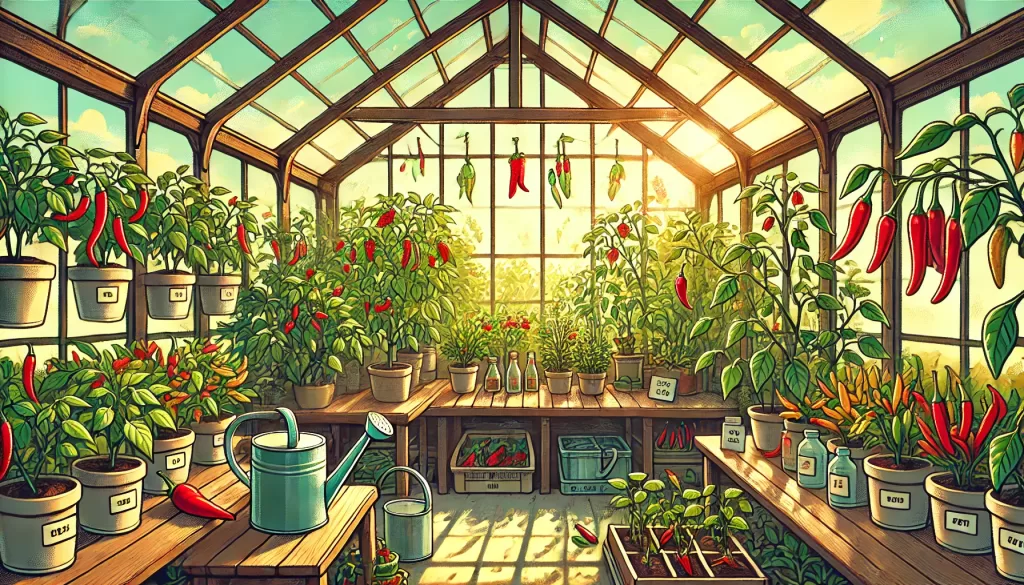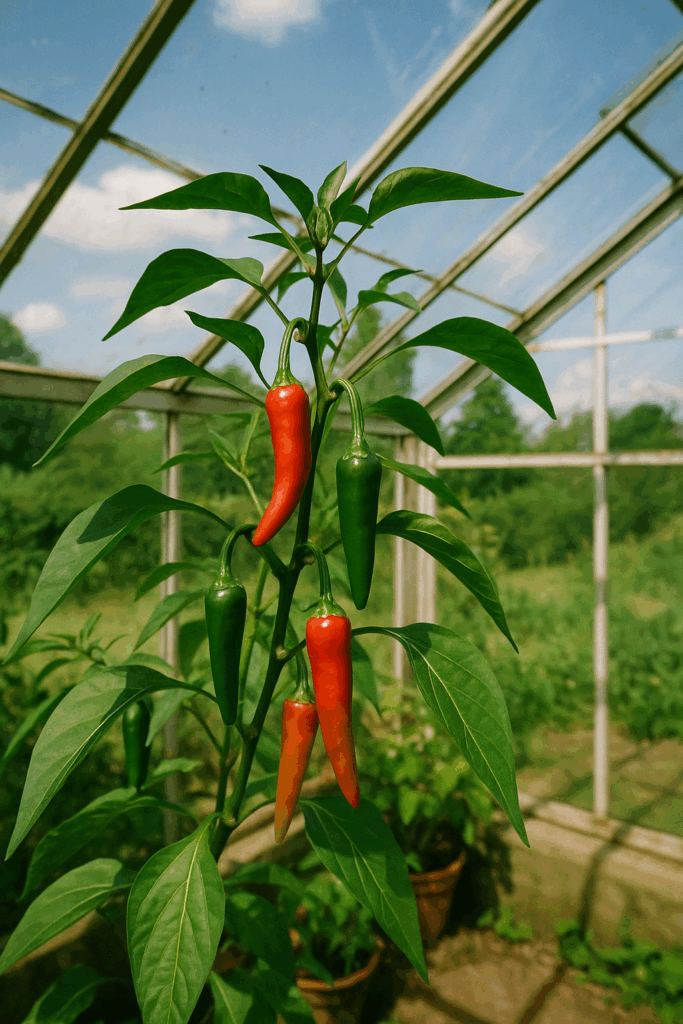Growing chillies in a greenhouse is a fantastic way to ensure a bountiful harvest, no matter the weather. Whether you’re a beginner or a seasoned gardener, cultivating chillies in a controlled environment can lead to healthier plants and earlier harvests compared to outdoor growing. In this guide, we wll cover everything from choosing the right varieties to troubleshooting common problems, ensuring you have all the knowledge to grow chillies successfully under glass.

Why Grow Chillies in a Greenhouse?
A greenhouse will provide a more stable environment compared to growing outdoors. Plants will be protected from lower night time temperatures. This is particularly helpful to chilli plants in spring and autumn. As a result growing in a greenhouse effectively extends the growing season of your plants which should mean earlier and bigger harvests.
Benefits of Greenhouse Grown Chillies:
- Longer growing season – Start seeds earlier and harvest later.
- Protection from extreme weather – Reduced exposure to extreme weather (high winds, heavy rain etc) means your pepper plants are more likely to thrive.
- Improved temperature control – Chillies thrive in warmth, and a greenhouse provides consistent conditions.
- Better fruit production – Controlled conditions tend to lead to higher yields and more intense flavours.
Choosing the Right Chilli Varieties
The first step to a successful chilli harvest is selecting the right varieties. Some chillies thrive better in greenhouse conditions than others. Here are a few popular choices:
- Jalapeño – A versatile, moderately hot chilli ideal for fresh use or pickling.
- Habanero – Extremely spicy with a fruity flavour, perfect for hot sauces.
- Cayenne – Great for drying and making chilli powder.
- Padron – Mild when young, but some can be surprisingly hot.
- Scotch Bonnet – A fiery chilli with a distinctive Caribbean flavour.
- Anaheim – A milder variety that is excellent for roasting.

Preparing Your Greenhouse for Chillies
Before growing chillies in a greenhouse, ensure your greenhouse is ready to provide the best conditions for growth. Here’s what you need to do:
Temperature and Humidity Control
Chillies prefer warm temperatures, ideally between 20-30°C (68-86°F). That said greenhouses can easily get too hot during summer which can scorch or stress plants. To avoid this you sould consider using shading or ventilation.
- Use automatic vents and/or fans to regulate heat.
- Consider shade netting to prevent scorching. I like to hang some horticultural fleece on the inside of the roof of the greenhouse to reduce the heat from midday sun a little inside the greenhouse.
- Keep humidity moderate, around 50-70%, to prevent fungal diseases. Always keep your greenhouse doors open unless severe weather is expected to promote good airflow.
- Always keep the greenhouse tidy. Remove and dispose of dead plants/leaves, wipe down dirty surfaces and keep the greenhouse clean at all times.
- Consider using a heater to keep the overnight temperature greater than 10 degrees celcius
Soil and Containers
- Use well-draining soil rich in organic matter.
- Grow chillies in pots, grow bags, or raised beds to manage space effectively.
- Add perlite or sand to improve drainage and aeration.
Related: See our guide to chilli potting mixes
Watering and Feeding
Chillies need consistent moisture but hate waterlogged roots. Growing peppers in a greenhouse often required more frequent watering than growing outside. Follow these tips:
- Water deeply but allow the soil to dry out between watering.
- Use rainwater if possible, as tap water can be too alkaline.
- Feed regulalry with a high-potassium fertiliser (like tomato feed) once flowers appear.
- Pot grown chillies will dry out quicker than those planted in the ground. CHeck twice a day of possible to ensure they do not dry out too much in warm weather.
Growing Chillies from Seeds
Starting chillies from seeds gives you access to a wide range of varieties. Here’s how to do it:
Sowing Seeds
- Start seeds indoors 8-10 weeks before the last frost.
- Use seed trays or small pots filled with fine seed compost.
- Sow seeds 1cm deep, cover lightly, and mist with water.
- Keep them in a warm location (20-25°C / 68-77°F) or use a heated propagator.
Germination and Transplanting
- Seeds typically germinate within 7-14 days.
- Once seedlings have 2-3 true leaves, transplant them into larger pots.
- Harden off young plants before moving them permanently into the greenhouse.
Related: Our detailed guide to germinating chilli seeds.
Caring for Your Chilli Plants
Once your plants are established, proper care will ensure a good harvest.
Supporting Growth
- Stake tall varieties to prevent branches from breaking under the weight of fruit.
- Pinch out the growing tips when plants reach 30cm (12 inches) to encourage bushier growth.
Pollination
Greenhouses limit natural pollination. To help:
- Gently shake flowers or use a small paintbrush to hand-pollinate.
- Keep the greenhouse door open during day time where possible to allow natural pollinators inside.
Common Pests and Diseases
While greenhouses offer protection, some pests and diseases can still pose problems.
Pests:
- Aphids – Use neem oil or introduce ladybirds.
- Spider mites – Keep humidity up and mist leaves.
- Whiteflies – Use yellow sticky traps.
Diseases:
- Blossom end rot – Caused by calcium deficiency; maintain consistent watering.
- Powdery mildew – Improve ventilation and avoid overhead watering.
Related: Read our detailed article on pests and diseases.
Harvesting and Storing Chillies
Chillies are ready to harvest once they reach their full size and colour. This can take anywhere from 60-150 days depending on the variety.
Best Practices for Harvesting:
- Use sharp scissors or pruners to avoid damaging the plant.
- Regular harvesting encourages more fruit production.
- Green chillies can be picked early for a milder flavour, while red chillies are fully matured and spicier.
Storing Your Chillies
- Fresh – Keep in the fridge for up to two weeks.
- Drying – String them up in a warm, dry place.
- Freezing – Store whole or chopped in airtight containers.
- Pickling – Preserve in vinegar for a tangy addition to dishes.
FAQs About Growing Chillies in a Greenhouse
Q: How long does it take for chillies to grow in a greenhouse? A: From seed to harvest, it usually takes 3-5 months depending on the variety and conditions.
Q: Can I grow chillies in an unheated greenhouse? A: Yes, but you may need to start seeds indoors (in your house) and move plants in to the greenhouse when temperatures rise. Here in the UK I typically aim to start my chilli seeds indoors in January or February.
Q: Why are my chilli flowers dropping off? A: This is often due to temperature fluctuations, overwatering, or lack of pollination. In a greenhouse this can often bedue to too high temperatures during the day. To avoid this ensure god ventilaion and use greenhouse shading.
Q: Can I overwinter chilli plants in my greenhouse? A: Yes! Cut them back, reduce watering, and keep them above 10°C (50°F). If you do not heat your greenhouse over winter you can move the plants to an unheated conservatory or a col windowsill in the house.
Final Tips for Success
- Choose varieties suited for greenhouse growing.
- Maintain warm, stable temperatures and good ventilation.
- Water consistently but avoid overwatering.
- Feed with a high-potassium fertiliser once flowering starts.
- Hand-pollinate flowers if needed for better fruiting.
- Harvest regularly to encourage more fruit.
Growing chillies in a greenhouse is rewarding and relatively easy with the right care. By following these tips, you’ll enjoy a plentiful harvest of fresh, homegrown chillies that can be used in everything from fresh salsas to fiery hot sauces!





